Last Chance to Catch NYC's Holiday Notalgia Train
We met the voices of the NYC subway on our nostalgia ride this weekend!


“Brazilian graffiti art is considered among the most significant strand[s] of a global urban art movement, and its diversity defies the increasing homogeneity of world graffiti.” – Design Week
In March 2009, the Brazilian government passed law 706/07 which decriminalizes street art. In an amendment to a federal law that punishes the defacing of urban buildings or monuments, street art was made legal if done with the consent of the owners. As progressive of a policy as this may sound, the legislation is actually a reflection of the evolving landscape in Brazilian street art, an emerging and divergent movement in the global street art landscape. In Brazil, there is a distinction made between tagging, known as pichação, and grafite, a street art style distinctive to Brazil.
The term pichação is derived from the Portuguese word piche or tar, which the early taggers would steal from construction sites and use as their creative medium. Rio de Janeiro has been particularly progressive in its policy towards street art, with its 1999 “Não pixe, grafite” (Don’t Tag, Graffiti) project that brought together 35 graffiti artists to showcase diversity in local styles. But more unique to street art in Rio de Janeiro is the evolution of a permission hierarchy, blurring the line between formal and informal, and obfuscating the line between illegal and legal. Law 706/07 merely reinforced these informal patterns of street art and legitimized an already flourishing form of artistic expression.
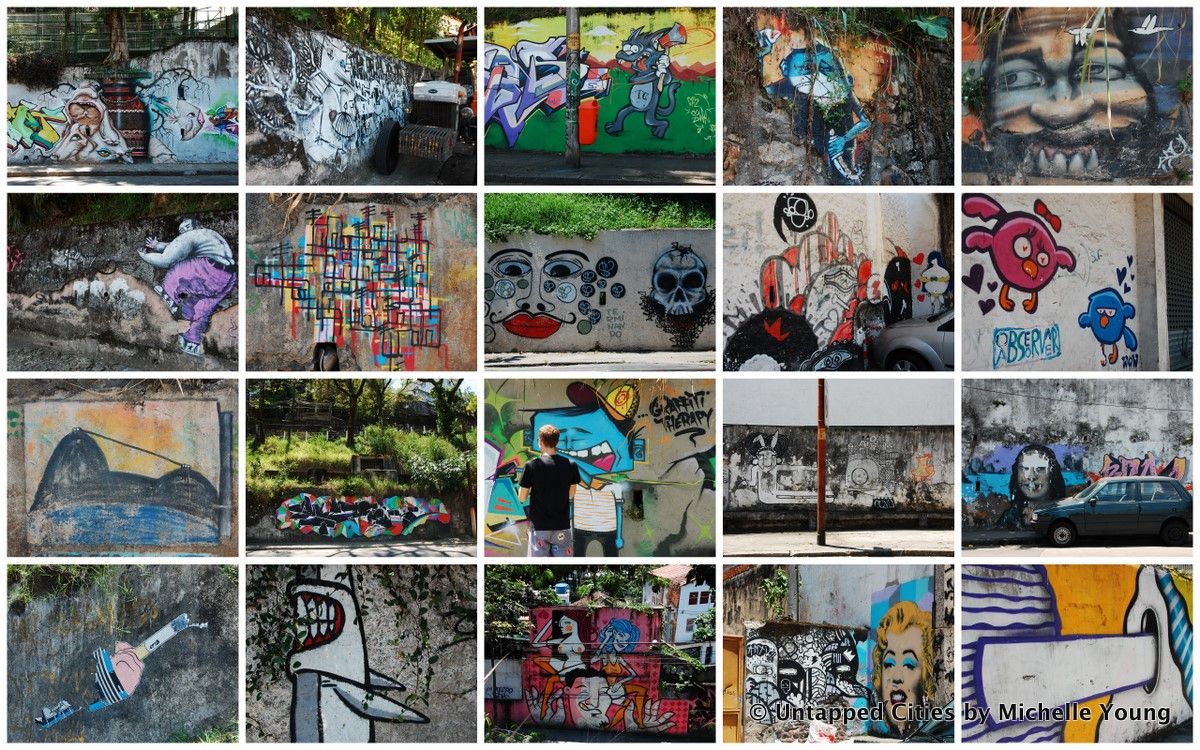 A sampling of street art in Rio de Janeiro in the Santa Theresa and Laranjeiras neighborhoods from October 2011 (click to enlarge)
A sampling of street art in Rio de Janeiro in the Santa Theresa and Laranjeiras neighborhoods from October 2011 (click to enlarge)
According to Rio de Janeiro artist Quito, whom I met at Columbia University’s Studio X in Rio, street art in the city is really an “agreement between the population and the city.” Street art began to flourish in Rio over the past ten years and Law 706/07 “came after the [development of] the art.” Quito believes that street art in Rio is currently having its “moment” with Rio artists going abroad to make their mark on foreign cities, while graffiti artists from all around the world are coming to the city to check out what’s been happening. When we spoke, Quito reinforced the differentiation between tagging and street art, echoing the words of Rio street artist Smael Vagner, a member of the Nação Crew: “The tagger wants to put his name on the wall, to be famous, and is a vandalist, but the [street] artist is interested in aesthetics and community.”
In Rio de Janeiro, the street art is ubiquitous. It exists in all corners of the city from the favela to upper class neighborhoods, from residential to institutional. It is bold in scale and aesthetics, and is anything but graffiti. The integration between street art and the urban fabric in all types of areas in Rio-residential, institutional, infrastructural, touristic-and across all socioeconomic neighborhoods is clear when one walks the streets. This article explores the hierarchy of permission between building owner and artist, how community is being developed in Rio through street art by artists, the city and non-profits, and how the urban fabric of Rio has contributed to the flourishing street art scene.
 Street art predominantly from Jardim Botânico and Santa Theresa from October 2011 (click to enlarge)
Street art predominantly from Jardim Botânico and Santa Theresa from October 2011 (click to enlarge)
Instead of the standard model of graffiti artists working illicitly on spaces, Quito sees four “situations of ownership” between artist and building owner in Rio:
I. Owners of buildings invite artists for commissions
This is done for various motivations:
i. Owners feel that a commissioned street art work can prevent tagging of their building
ii. The owner cannot afford to beautify his faà§ade and will choose to decorate it with street art instead
iii. Aesthetic choice: the owner prefers street art on his building
II. Street artists ask permission from the owner
III. Street art is created with no permission at places with owners
IV. Street art is created at locations with no ownership
While the majority of street art occurs in Category III and IV, the existence of the first and second categories is a striking shift in production of street art and its relationship with the community. Furthermore it questions the prevailing discourse of a graffiti artist taking back the streets solo in rebellion against authority. In Brazil, the artist sometimes works in conjunction with the owners of buildings to collectively alter the space and the motives vary.
Building Community through Street Art
The idea of creating a community through street art has manifested on numerous different levels. At the city level, there are different levels of participation by the government. One is to permit large-scale graffiti on underutilized and decaying walls and to not authorize “paint-overs.” The most prominent location where this has occurred is the half-mile stretch along the high security walls of the Rio de Janeiro Jockey Club (Jócquei Clube Rio de Janeiro), situated across from the Botanical Garden (Jardim Botânico).
 Street art on the walls of the Jardim Botânico from October 2011
Street art on the walls of the Jardim Botânico from October 2011
Quito believes the graffiti on the wall is on its third layer. According to Lu Olivero, who heads the AEROSOuL CARIOCA project in partnership with community organization, Mundo Real, Rio’s street artists come to this wall to “make a name for themselves. It is, in my estimation, the largest collection of street art in the city, reserved for only the best. If Street Art had a professional league, the wall at Jardim Botânico would be the NBA.”
AEROSOuL CARIOCA has catalogued the entire wall in photographs, capturing 400 pieces of art by 300 different artists. Olivero says that the most interesting element of the wall is that “it’s almost a competition. The pieces, nestled closely on the gray cement walls, are often referenced by the pieces they are next to, so if your piece is good, the artist that comes along after has to create something even better.”
Cities are also directly involved in street art projects. São Paulo introduced the law Lei Cidade Limpa that was intended to prohibit billboard marketing in the city but had the unintended consequence of turning the city into a blank slate for mural art and graffiti. São Paulo now integrates street art into urban policies to revitalize neighborhoods. The city also developed criteria to catalogue works of art painted with permission from the building owner.
Caramundo, a Netherlands-based non-profit operating in Brazil contends that, “Graffiti and street art are used to uplift neglected urban areas and stimulate safety in those areas by involving local residents and by stimulating creativity.” On the other hand, a city-run street art initiative in the Lapa neighborhood of Rio de Janeiro raised issues regarding whether promoting a beer brand in the art was a questionable decision on the part of the government. In São Paulo, the city has prohibited street art used as advertising.
In “Women are Heroes,” French artist JR famously canvassed the Providencia favela in Rio de Janeiro with the eyes and portraits of women who had lost a loved one in violence with the police. But more than art, JR actively involves the community to add an architectural (and philanthropic) element to his work.
In Kenya, JR used vinyl on the roofs to protect the slums from the rain. “In each place,” he says, “the people had to find their own interest in the project. In places like Kenya or Brazil, the confrontation and the experience with the people was so strong, that it made us want to come back and keep a link with those people.” He also believes these projects have a life even after the photographs disintegrate with the elements: “Sometimes the wave of the project can be read even when the photo is done.”
Another well-known project is the colorful facades of the Santa Marta favela, an initiative by artists Jeroen Koolhaas and Dre Urhahn, who worked up with the Let’s Colour Project (an initiative of the Delux paint company). Known as Tudo de cor para você, the project aimed to “inspire people through the preservation and injection of color that was given to the community’s houses.” According to Quito, this project was also successful due to favela residents’ preconceptions of their homes. They are interior focused, with any upgrades done in the areas where they will be living. As a result, it was not difficult to motivate an entire neighborhood to join forces into one unified work of art, covering over 7000 square meters of faà§ade. The project involved fifty members of the neighborhood and was painted using 2,000 liters of donated paint.
On a more permanent basis, Projeto Queto is a community organization founded by Francisco da Silva, the founder and leader of the graffiti team, Nação Crew. With support from the non-profit organization Caramundo and funding in part from the Dutch Governmental Institute NCDO Building Bridges and Plan Nederland, a community center was set up in Sampaoi, the favela in Rio’s north zone where da Silva grew up. Anouk Piket of Caramundo speaks of the inspirational potential of graffiti in the favelas, along with its ability to establish discipline and structure: “We hope to inspire the youth to learn more and read more: to discover what life has to offer outside their day-to-day existence”¦The participants not only learn about graffiti techniques, but come into contact with art, culture, and language. Letters are important in graffiti, which means that reading and writing are also addressed in the workshops.”
In addition to graffiti workshops, Projeto Queto also offers classes in audio production, silkscreen printing, sewing and fashion design. The end goal is to assist not only the creative process, but also in employment and the creation of small businesses. Smael Vagner, another member of Naà§à£o Crew believes vocational opportunities are a byproduct of practicing street art: “Graffiti has created a new horizon for young people that have gone on to become artists and teachers. There are cases in which drug traffickers are now graffiti artists. It’s a gateway to a new perspective on life for the poor in favelas who don’t have other opportunities.” While it is too soon to tell if these statements are utopian hopes, it is clear that the momentum for street art at the community level is strong and the city and state are on board to help create an environment in which it can flourish.
The urban fabric of Rio de Janeiro also contributes to the street art scene. The high walls, whether for security or to contain the topography, provide ample surfaces for painting. Rather than the location dictating the art, the relationship between owner and artist has a direct impact on the location. Nevertheless, it is interesting to note where the street art occurs. These observations are primarily based on walking through the Santa Theresa and Laranjeiras neighborhoods. In the explanation and photographic examples, I will also describe the ownership conditions in which the art is created where applicable.
Infrastructure Walls
 Santa Theresa, photo by Luisa Mendez from Columbia University GSAPP
Santa Theresa, photo by Luisa Mendez from Columbia University GSAPP
This piece of street art in Santa Theresa is an example of art on an infrastructure wall which exists due to the topography and the need for an entrance for both pedestrian (staircase on the right) and car (ramp on the left). It exists along a winding road that continues up a steep incline to the rest of the neighborhood and there are no ground level commercial activities. However, it has become an informal public place, a hang out spot for youth. This type of formation is repeated elsewhere in the neighborhood with the same unintended social effect:
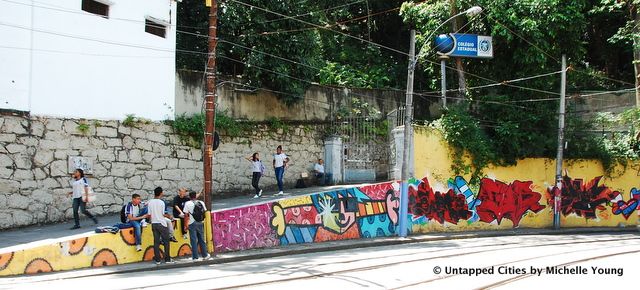
While the presence of the school naturally increases the likelihood of street activity, the socialization occurs on narrow sidewalks that would not ordinarily be conducive to gathering. The ledge, incline and color help turn basic infrastructure into active spots of engagement and informal public space.
When a concrete infrastructure wall is long enough, it becomes a continuous canvas with the works existing in relationship to one another. Aesthetically they often blend into or layer onto one another.


 Panorama photographs: top by Michelle Young, others by Charles Able from Columbia University GSAPP
Panorama photographs: top by Michelle Young, others by Charles Able from Columbia University GSAPP
In multiple locations in Santa Theresa, the panels also have a relationship with one or more parallel walls below:
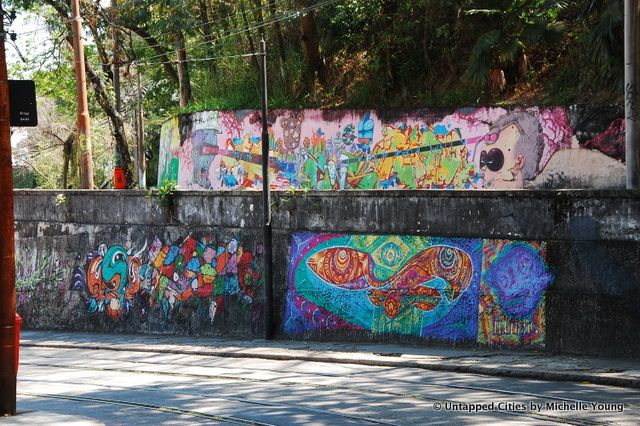
Residential Security Walls
There are several categories of street art and graffiti on security walls. The first is tagging.

It is therefore not surprising that some owners commission street art for their security walls as a means to prevent tagging. The tacit agreement among street artists is striking, with this piece in place since 2006.

Residential security walls in favelas also get street art treatment, albeit with less sophisticated techniques and rendering (as per below). However, Quito believes the agreement between owner and artists holds in the favelas as well and may even be more pervasive due to the tendency to construct based on need, from the inside of the house out.
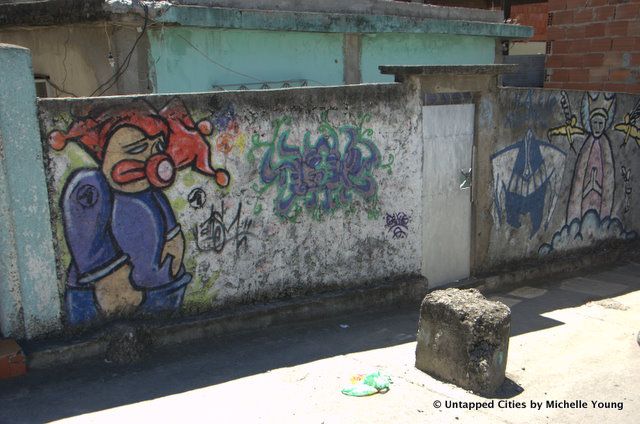
Commercial Security Walls
The same principle appears to hold true for commercial security walls, but perhaps with initiative originating with the owner instead of the artist.
 Photograph by Ivy Chan from Columbia University GSAPP
Photograph by Ivy Chan from Columbia University GSAPP

Another variant of this situation is when a street art wall completely encircles a property. The Hospital Federal de Lagoa just down the street from the wall at Jardim Botânico has about 100 pieces of art by 70 different artists:
 Image Source: Google Street View
Image Source: Google Street View
Junctures/Corners
This situation typically occurs in commercial and institutional zones. In some cases the wall encloses a vacant lot (top photo), in other cases the wall encloses an active property, like the jockey club (bottom).
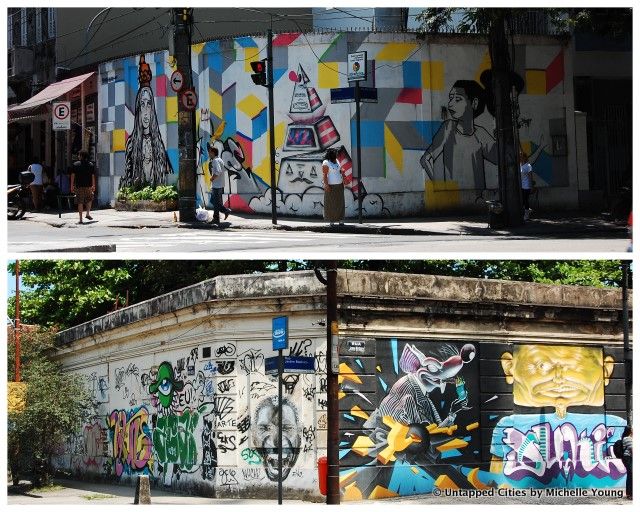
Public Spaces
Street art is present in official public spaces such as playgrounds and soccer fields, but is less organized or coherent spatially than in areas the street artists have officially claimed, such as the wall at Jardim Botânico or the long infrastructure walls in Santa Theresa.
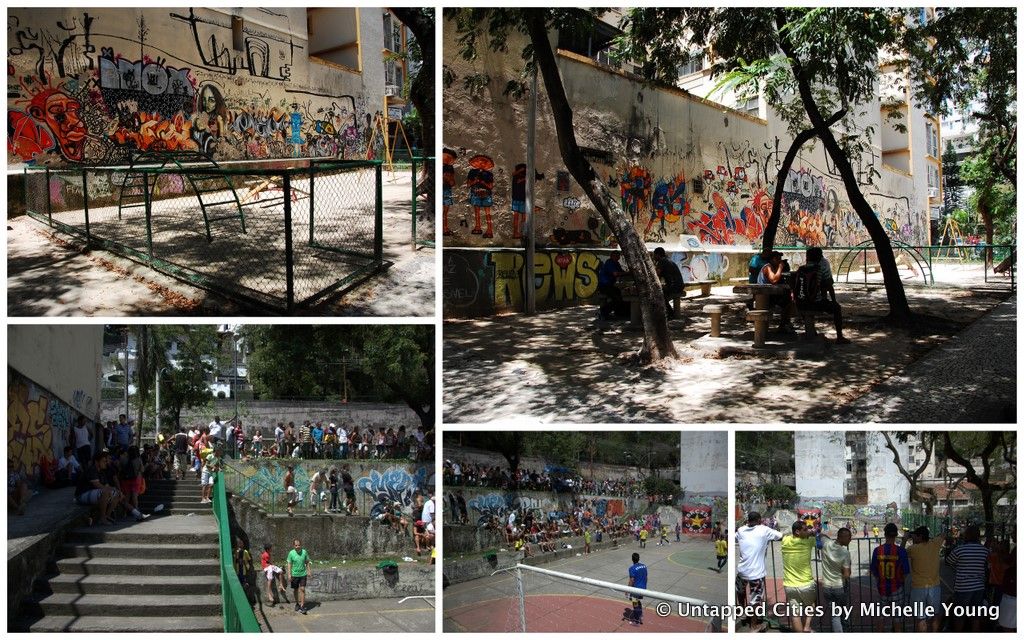
Hybrid

Schools represent a hybridization of the typical street art situation. The security walls of schools in Rio de Janeiro are traditionally painted, originating before the development of graffiti and street art in Brazil.
This article is excerpted from a project I did for the Operation Barra Megamix Studio, an architecture studio at Columbia University GSAPP. The work from this studio, which focused on architectural and urban interventions in Barra da Tijuca, will be exhibited at Studio X Rio de Janeiro in March, along with a street art video by AEROSOuL CARIOCA
Follow Untapped Cities on Twitter and Facebook! Get in touch with the author @untappedmich.
Subscribe to our newsletter